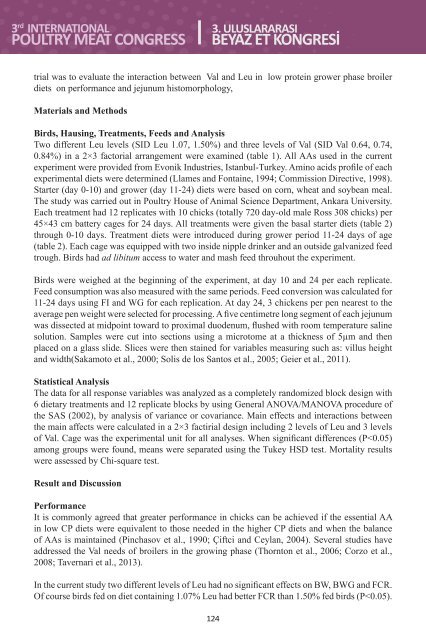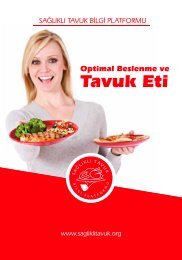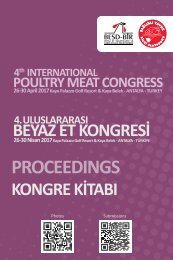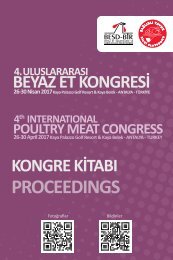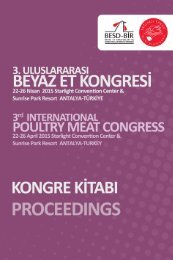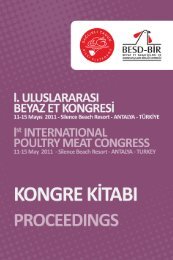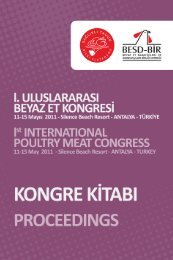3rd International Poultry Meat Congress
Proceedings
Proceedings
Create successful ePaper yourself
Turn your PDF publications into a flip-book with our unique Google optimized e-Paper software.
trial was to evaluate the interaction between Val and Leu in low protein grower phase broiler<br />
diets on performance and jejunum histomorphology,<br />
Materials and Methods<br />
Birds, Hausing, Treatments, Feeds and Analysis<br />
Two different Leu levels (SID Leu 1.07, 1.50%) and three levels of Val (SID Val 0.64, 0.74,<br />
0.84%) in a 2×3 factorial arrangement were examined (table 1). All AAs used in the current<br />
experiment were provided from Evonik Industries, Istanbul-Turkey. Amino acids profile of each<br />
experimental diets were determined (Llames and Fontaine, 1994; Commission Directive, 1998).<br />
Starter (day 0-10) and grower (day 11-24) diets were based on corn, wheat and soybean meal.<br />
The study was carried out in <strong>Poultry</strong> House of Animal Science Department, Ankara University.<br />
Each treatment had 12 replicates with 10 chicks (totally 720 day-old male Ross 308 chicks) per<br />
45×43 cm battery cages for 24 days. All treatments were given the basal starter diets (table 2)<br />
through 0-10 days. Treatment diets were introduced during grower period 11-24 days of age<br />
(table 2). Each cage was equipped with two inside nipple drinker and an outside galvanized feed<br />
trough. Birds had ad libitum access to water and mash feed throuhout the experiment.<br />
Birds were weighed at the beginning of the experiment, at day 10 and 24 per each replicate.<br />
Feed consumption was also measured with the same periods. Feed conversion was calculated for<br />
11-24 days using FI and WG for each replication. At day 24, 3 chickens per pen nearest to the<br />
average pen weight were selected for processing. A five centimetre long segment of each jejunum<br />
was dissected at midpoint toward to proximal duodenum, flushed with room temperature saline<br />
solution. Samples were cut into sections using a microtome at a thickness of 5μm and then<br />
placed on a glass slide. Slices were then stained for variables measuring such as: villus height<br />
and width(Sakamoto et al., 2000; Solis de los Santos et al., 2005; Geier et al., 2011).<br />
Statistical Analysis<br />
The data for all response variables was analyzed as a completely randomized block design with<br />
6 dietary treatments and 12 replicate blocks by using General ANOVA/MANOVA procedure of<br />
the SAS (2002), by analysis of variance or covariance. Main effects and interactions between<br />
the main affects were calculated in a 2×3 factirial design including 2 levels of Leu and 3 levels<br />
of Val. Cage was the experimental unit for all analyses. When significant differences (P


